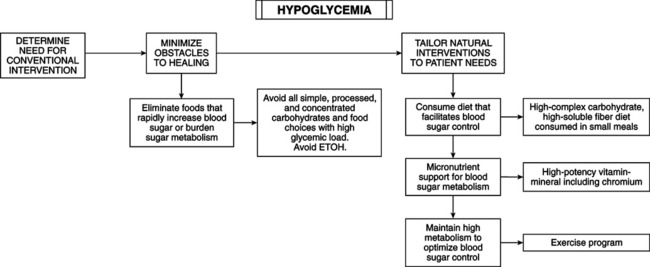Hypoglycemia is divided into two main categories: • Reactive hypoglycemia: most common form. Symptoms of hypoglycemia occur 3-5 hours after a meal and may herald onset of early type 2 diabetes mellitus (DM). Gastric surgery may induce this condition, and anorexia nervosa may be a cause. It may also result from oral hypoglycemic drugs; these sulfa drugs (sulfonylureas) stimulate secretion of additional insulin by the pancreas and enhance tissue sensitivity to insulin. (See list of other hypoglycemic drugs below.) Some call this category “idiopathic postprandial syndrome” because symptoms exist and are related to rapid glucose drops, but absolute glucose levels are not reliable indicators of syndrome. Many asymptomatic control subjects have glucose levels <50 mg/dL and many symptomatic patients have normal postprandial glucose. • Fasting hypoglycemia: rare; appears in severe disease states (pancreatic tumors, extensive liver damage, prolonged starvation, autoantibodies against insulin or its receptor, various cancers, excessive exogenous insulin in diabetics). Pregnant diabetic women taking insulin or oral glycemic drugs also can have asymptomatic hypoglycemia. • Glucose tolerance test (GTT): used to diagnose reactive hypoglycemia and DM, but rarely required for DM. After fasting 12+ hours, measure baseline blood glucose. Give subject glucose drink; the amount consumed is based on body weight (1.75 g/kg body weight). Measure blood sugar at 30 minutes, 1 hour, and then hourly for up to 6 hours. Levels >200 mg/dL indicate DM. Levels <50 mg/dL indicate reactive hypoglycemia (see table on p. 374). • Glucose-insulin tolerance test (G-ITT): blood sugar levels alone are often not enough to diagnose hypoglycemia; signs and symptoms of hypoglycemia occur in persons with glucose >50 mg/dL. Wide overlap exists between symptomatic patients and asymptomatic control subjects. Symptoms linked to hypoglycemia arise from increases in insulin or epinephrine (adrenaline). Measure insulin or epinephrine during GTT because symptoms often correlate better with hormones than glucose. G-ITT has greater sensitivity in diagnosing hypoglycemia and DM than does GTT. Use standard 6-hour GTT coupled with measurements of insulin. Two-thirds of subjects with suspected DM or hypoglycemia with normal GTT demonstrate abnormal G-ITT. However, G-ITT is costly. • Hypoglycemic index: helps diagnose borderline hypoglycemia. The value is determined by calculating the fall in blood glucose during a 90-minute period before the lowest point divided by the value of the lowest point. Hypoglycemic index >0.8 indicates reactive hypoglycemia. • Hypoglycemia questionnaire: most useful and cost-effective method of diagnosing hypoglycemia is to assess symptoms. When symptoms appear 3-4 hours after eating and disappear with ingestion of food, consider hypoglycemia (see questionnaire on p. 375). • Brain: dependent on glucose as energy source. Hypoglycemia causes brain dysfunction. Hypoglycemia is involved in various psychological disorders. Depressed individuals show high percentage of abnormal GTT and G-ITT, but rarely is hypoglycemia considered and dietary therapy prescribed. • Aggressive and criminal behavior: Reactive hypoglycemia is common in psychiatric patients and habitually violent and impulsive criminals. Abnormal and emotionally explosive behavior often is seen during GTT. A sugar-restricted diet reduced antisocial behavior among male juvenile inmates. Behavior improved most in those charged with assault, robbery, rape, aggravated assault, auto theft, vandalism, child molestation, arson, and possession of a deadly weapon. Dietary changes did not seem to affect female prisoners. Men may react to hypoglycemia in a different manner from women; hypoglycemia is an innate internal signal for men to hunt for food. In noncriminal men, aggressiveness often coincides with hypoglycemia. • Premenstrual syndrome (PMS): PMS-C is linked with increased appetite, craving for sweets, headache, fatigue, fainting spells, and heart palpitations. GTT on PMS-C patients 5-10 days before menses displays flattening of early part of curve and reactive hypoglycemia. GTT is normal during other parts of menstrual cycle. Flat, early part of GTT curve implies excessive insulin secretion in response to sugar consumption. Excessive secretion is hormonally regulated, but other factors are involved. Sodium chloride ingestion enhances insulin response to sugar, and decreased magnesium in pancreas increases insulin secretion (see the chapter on premenstrual syndrome). • Migraine headaches: caused by excessive dilation of blood vessels in the head. Migraines are surprisingly common (15%-20% of men and 25%-30% of women). More than half have a family history of migraine. Hypoglycemia is a common precipitating factor. Eliminating refined sugar from diets of migraine sufferers with confirmed hypoglycemia greatly improves the condition (see the chapter on migraine headaches). • Atherosclerosis, intermittent claudication, and angina: reactive hypoglycemia or impaired glucose tolerance is a significant factor in atherosclerosis. High sugar intake elevates triglycerides and cholesterol. Abnormal GTT and hyperinsulinism are common in patients with heart disease. High sugar intake and reactive hypoglycemia can cause angina and intermittent claudication. • Syndrome X: a set of cardiovascular risk factors (glucose or insulin disturbances, hyperlipidemia, hypertension, and android obesity). Other terms include metabolic cardiovascular risk syndrome, Reaven’s syndrome, insulin resistance syndrome, and atherothrombogenic syndrome. The underlying metabolic denominator is hyperinsulinemia from elevated intake of refined carbohydrates. Development of type 2 DM is preceded by hyperinsulinemia and insulin insensitivity. In most cases these defects present themselves decades before the development of DM. Hypoglycemia, hyperinsulinemia, syndrome X, and type 2 DM are progressive stages of the same illness—maladaptation to the refined Western diet.
Hypoglycemia
INTRODUCTION

DIAGNOSTIC CONSIDERATIONS
GENERAL CONSIDERATIONS
Health Impact of Hypoglycemia
![]()
Stay updated, free articles. Join our Telegram channel

Full access? Get Clinical Tree


Hypoglycemia
